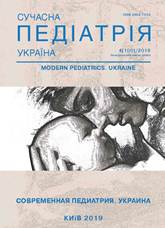Клініко-епідеміологічний аналіз материнських чинників схильності до неонатального сепсису за умов різного екологічного впливу
Abstract
Мета: для покращення результатів діагностики і лікування неонатального сепсису вивчити особливості материнських чинників схильності до його розвитку в контрастних за екологічними характеристиками регіонах проживання вагітних.
Матеріали і методи. Проведено клініко9епідеміологічний аналіз впливу материнських чинників схильності на формування неонатального сепсису у 260 новонароджених залежно від екологічних характеристик місць проживання вагітних.
Результати. Встановлено, що за відсутності суттєвих розбіжностей у показниках репродуктивного здоров'я, а також соматичної патології й акушерсько-гінекологічного анамнезу, проживання вагітних у несприятливих умовах супроводжується удвічі вищим ризиком невиношування вагітності і народження дітей у терміні гестації до 35 тижнів (ВШ=2,04; 95% ДІ 1,2–3,7), народження дітей з екстремально низькою масою тіла (ВШ=2,9; 95% ДІ 1,1–7,3), а також вірогідно нижчою оцінкою за шкалою Апгар на 59й хвилині життя новонародженого (ВШ=5,12; 95% ДІ 2,1–12,6).
Висновки. Вказані зміни можуть бути розцінені які наслідок хронічного контакту вагітних із забрудненням територій їх проживання.
Дослідження було виконане відповідно до принципів Гельсінської Декларації. Протокол дослідження погоджений Локальним етичним комітетом (ЛЕК) установи. На проведення досліджень була отримана поінформована згода батьків дітей або їхніх опекунів.
References
Derzhavna sluzhba statystyky Ukrainy. Holovne upravlinnia statystyky u Chernivetskii oblasti. Statystychnyi shchorichnyk Chernivetskoi oblasti za 2017 rik: 543.
Derzhavna sluzhba statystyky Ukrainy. Holovne upravlinnia statystyky u
Khmelnytskii oblasti. Statystychnyi shchorichnyk Khmelnytskoi oblasti za 2017 rik: 514.
Altunhan H, Annagur A, Ors R et al. (2011). Procalcitonin measurement at 24 hours of age may be helpful in the prompt diagnosis of early-on-set neonatal sepsis. Int J Infect Dis.15(12): e854–858. https://doi.org/10.1016/j.ijid.2011.09.007; PMid:22019570
Auriti C, Fiscarelli E, Ronchetti MP et al. (2012). Procalcitonin in detecting neonatal nosocomial sepsis. Arch. Dis. Child. Fetal. Neonatal. Ed. 97(5): F368–370. https://doi.org/10.1136/fetalneonatal-2010-194100; PMid:22933097
Barouki R, Melen E, Herceg Z, Beckers J et al. (2018). Epigenetics as a mechanism linking developmental exposures to long-term toxicity. Environment international. 114: 77–86. https://doi.org/10.1016/j.envint.2018.02.014; PMid:29499450 PMCid:PMC5899930
Bollati V, Baccarelli A. (2010). Environmental epigenetics. Heredity. 105(1): 105–112. https://doi.org/10.1038/hdy.2010.2; PMid:20179736 PMCid:PMC3133724
Chiesa CL, Natale F, Pascone R et al. (2011). C4reactive protein and procalcitonin: reference intervals for preterm and term newborns during the early neonatal period. Clin Chim Acta. 412 (11–12): 1053–1059. https://doi.org/10.1016/j.cca.2011.02.020; PMid:21338596
Dritsakou K, Liosis G, Gioni M et al. (2015). CRP levels in extremely low birth weight (ELBW) septic infants. J Matern Fetal Neonatal Med.28(2): 237–239. https://doi.org/10.3109/14767058.2014.908842; PMid:24670235
Ezziane Z. (2013). The impact of air pollution on low birth weight and infant mortality. Reviews on Environmental Health. 28(2–3): 107–115. https://doi.org/10.1515/reveh-2013-0007; PMid:24192497
Fleischmann4Struzek C, Goldfarb DM, Schlattmann P, Schlapbach LJ, Reinhart K, Kissoon N. (2018). The global burden of paediatric and neonatal sepsis: a systematic review. Lancet Respir Med.6(3): 223–30. https://doi.org/10.1016/S2213-2600(18)30063-8
Genowska A, Jamiolkowski J, Szafraniec K, Stepaniak U, Szpak A, Pajak A. (2015). Environmental and socio4economic determinants of infant mortality in Poland: an ecological study. Environmental health. 14:61. https://doi.org/10.1186/s12940-015-0048-1; PMid:26195213 PMCid:PMC4508882
Getabelew A, Aman M, Fantaye E, Yeheyis T. (2018). Prevalence of Neonatal Sepsis and Associated Factors among Neonates in Neonatal Intensive Care Unit at Selected Governmental Hospitals in Shashemene Town, Oromia Regional State, Ethiopia, 2017. Int J Pediatr. https://doi.org/10.1155/2018/7801272; PMid:30174698 PMCid:PMC6098917
Hornik CP, Fort P, Clark RH, Watt K et al. (2012). Early and late onset sepsis in very-low-birth-weight infants from a large group of neonatal intensive care units. Early Hum. Dev. 88 (2): 69–74. https://doi.org/10.1016/S0378-3782(12)70019-1
Kamalakannan SK. (2018). Neonatal Sepsis Past to Present. Biomed J Sci & Tech Res. 3(3): 1–6. https://doi.org/10.26717/BJSTR.2018.03.000909
Kihal-Talantikite W, Zmirou-Navier D, Padilla C, Deguen S. (2017, May). Systematic literature review of reproductive outcome associated with residential proximity to polluted sites. International journal of health geographics.16: 20. https://doi.org/10.1186/s12942-017-0091-y; PMid:28558782 PMCid:PMC5450119-y
Pammi ML, Weisman LE. (2015). Late4onset sepsis in preterm infants: update on strategies for therapy and prevention. Expert Rev. Anti Infect. Ther. 13 (4): 487–504.
Shane AL, Stoll BJ. (2014). Neonatal sepsis: Progress towards improved outcomes. J Infect. 68;1: 24–32. https://doi.org/10.1016/j.jinf.2013.09.011; PMid:24140138
Singer M, Deutschman CS, Seymour CW et al. (2016). The Third International Consensus Definitions for Sepsis and Septic Shock (Sepsis43). JAMA.315(8):801—10. https://doi.org/10.1001/jama.2016.0287; PMid:26903338 PMCid:PMC4968574.
Stoll BJ, Hansen NI, Bell EF et al. (2015). Trends in Care Practices, Morbidity, and Mortality of Extremely Preterm. Neonates, 1993—2012. JAMA. 314 (10): 1039. https://doi.org/10.1001/jama.2015.10244; PMid:26348753 PMCid:PMC4787615
Downloads
Issue
Section
License
The policy of the Journal “MODERN PEDIATRICS. UKRAINE” is compatible with the vast majority of funders' of open access and self-archiving policies. The journal provides immediate open access route being convinced that everyone – not only scientists - can benefit from research results, and publishes articles exclusively under open access distribution, with a Creative Commons Attribution-Noncommercial 4.0 international license (СС BY-NC).
Authors transfer the copyright to the Journal “MODERN PEDIATRICS. UKRAINE” when the manuscript is accepted for publication. Authors declare that this manuscript has not been published nor is under simultaneous consideration for publication elsewhere. After publication, the articles become freely available on-line to the public.
Readers have the right to use, distribute, and reproduce articles in any medium, provided the articles and the journal are properly cited.
The use of published materials for commercial purposes is strongly prohibited.

